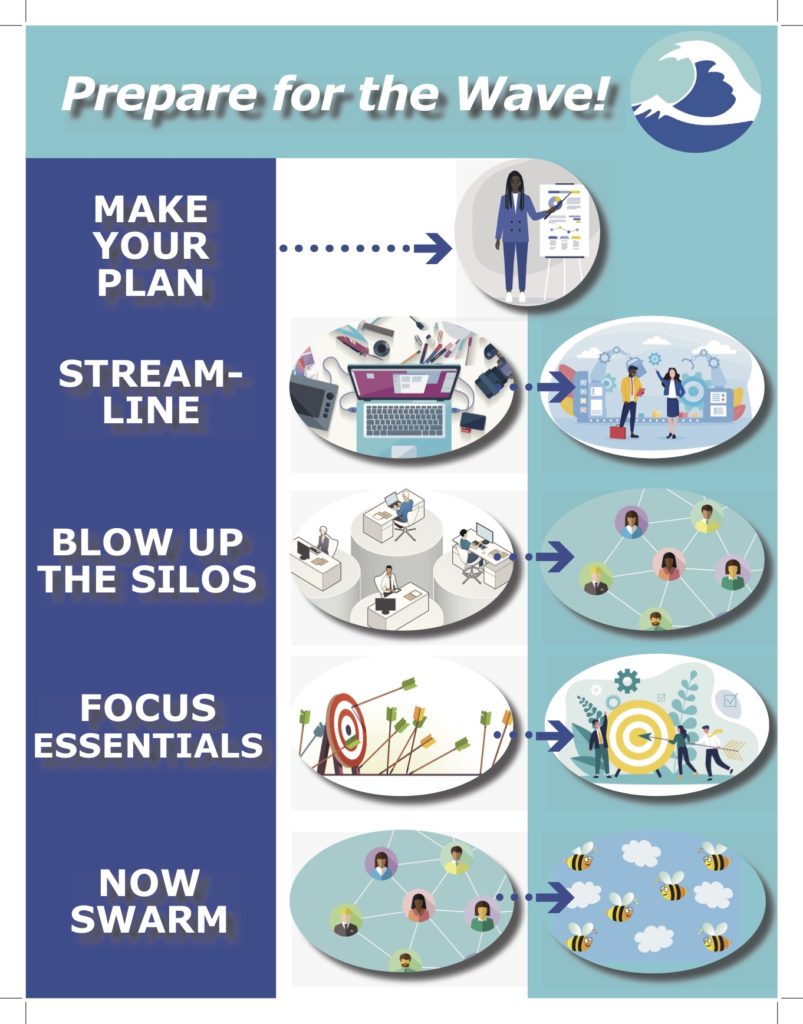
Early indications are that there is a pent-up demand for your in-person classes, and that when you restart and/or expand your in-person classes again you may experience increased registrations. Clearly, you should continue to offer classes in the online and Live Online/Zoom formats.
The possibility of increased registrations comes when some programs are also experiencing budget and sometimes staffing cutbacks. Thus this Exclusive LERN Member-Only Report on “Preparing for the Wave.”
The central idea to blow up your silos came from your LERN Leaders and experience with their programs.
New! Blow Up the Silos
Here we Recommend for the first time you Blow Up Your Silos, making staffing more flexible and responsive. We Recommend that up to 25% of each staff person’s time be made available for program-wide essential functions during critical time periods for programs with staff of more than 5 FTE (full time equivalent) employees; and we Recommend that up to 50% of each staff person’s time be made available for program-wide essential functions during critical time periods for programs with staff of 5 or fewer FTE (full time equivalent) employees
Prepare for the Wave
Here is our 5 Stage recommended plan for preparing for a return to in-person classes, increased registrations, and address more limited staffing.
I.MAKE YOUR PLAN
1.Announce.
Announce to staff the new Blow Up the Silos strategy.
Explain Why you need to do this.
2.Get input from staff.
Allow and welcome input from each staff member.
3.Discuss Revisions.
Discuss with staff revising, streamlining, and cutting everything, including: policies, procedures, courses, programs, meetings.
Discuss what classes might have increased attendance, and need extra space.
4.Decide on Essential ‘swarm’ tasks and time frames.
You have certain Essential tasks and activities, like marketing and registration, where any-all staff can and should be asked to help out.
Determine the start and end time for each of the Essential tasks where swarming occurs.
5.Inform staff of the new plan.
Summarize WHY again.
Now explain HOW.
Reiterate with a one page written summary.
Thank and praise staff.
II. STREAMLINE
Now Cut the loser classes and programs; Now bolster the winners by featuring them more, offering them more, marketing them more, providing extra space.
Now Cut non-essential activities, tasks and other staff duties. Cut the “nice” things you do; focus on the “critical” things you do.
III. BLOW UP THE SILOS
Assign any and all staff with helping with essential and time-critical tasks and activities not necessarily in the person’s job description. Be sure you have explained Why this is needed, and How it will work.
If someone says, “It’s not in my job description,” Your response, “Now it is.” Use “Other duties as assigned” as needed. In general, most staff will be willing to help and understand their contribution is for the good of all. Approach this positively, as it may be a permanent part of how lifelong learning programs and continuing education units function moving forward. Keep each person’s ‘regular’ duties as is.
Rough guideline
For staff of more than 5 FTE (full time equivalent) employees: Up to 25% of each staff person’s time be made available for program-wide essential functions during critical time periods.
For staff of 5 or fewer FTE (full time equivalent) employees: up to 50% of each staff person’s time be made available for program-wide essential functions during critical time periods. employees
IV. FOCUS ON ESSENTIALS
Decide the Essential functions where you need other staff to help out. They might include:
-Create new classes.
-Design and produce the print brochure.
-Market your classes.
-Register for your classes.
-Customer service.
-Run Operations and logistics.
Pick what staff are best and needed for helping out on the Essential functions. The number and choice of individuals may be different for each Essential function.
Create time frames. You need a definite and stated Beginning date for each Essential function where you need extra help. Do not have everyone ‘on call’ every day throughout the year. You need a definite and stated End date.
V. NOW SWARM
During your Essential timeframes and critical times do:
-Daily checks on staffing priorities and time allocation.
-Weekly pep talks.
-Weekly input from each staff person.
Do daily checks:
-Incoming registrations and work.
-What’s not been done.
At the end
At the end of each critical Swarm time frame,
-Announce the end and
-Congratulate/praise/thank staff.
